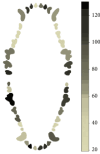Periodontal Disease in Dogs From Mexico: Description of Most Commonly Affected Teeth and Associated Factors
- PMID: 40224251
- PMCID: PMC11986946
- DOI: 10.1155/vmi/6628061
Periodontal Disease in Dogs From Mexico: Description of Most Commonly Affected Teeth and Associated Factors
Abstract
With the objective to evaluate the prevalence of periodontal disease (PD) and monitor the most affected teeth in dogs under the subtropical conditions in Mexico, 184 randomly selected dogs underwent a periodontal examination. Of the evaluated dogs, 78.8% showed some degree of gingivitis most of them (76.6%) with a moderate index, and 30.4% presented some degree of PD being most of them of a mild degree. Old age and small size dogs were more prone to develop PD as reported elsewhere. Higher mobility index and furcation were seen in maxillary teeth 108 and 208 and mandibular teeth 308 and 408, but some other teeth were involved in less proportion. On probing, bleeding was observed in maxillary teeth 202, 11, 102, and 202 and mandibular teeth 309 and 409. Dental plaque and calculus were more frequent in maxillary teeth 202 and 102 and mandibular teeth 309, 310, and 409. Finally, dental loss was observed with more frequency in all maxillary incisors (102, 201, and 202) and molars 109 and 209; mandibular molars 411 and 311 were more prompt to be losed. This study demonstrates the high prevalence of gingivitis and development of PD in dogs in subtropics in Mexico and reveals the predisposition of some maxillary and mandibular teeth to develop PD and consequently their loss. The clinical implications of the study indicate that special attention should be paid to these teeth to be checked when the dogs come for consultation, during brushing and in dental prophylaxis.
Copyright © 2025 Ana G. Villegas-Ferre et al. Veterinary Medicine International published by John Wiley & Sons Ltd.
Conflict of interest statement
The authors declare no conflicts of interest.
Figures





Similar articles
-
A correlative study of the clinical and radiographic signs of periodontal disease in dogs.J Am Vet Med Assoc. 1985 Jun 15;186(12):1286-90. J Am Vet Med Assoc. 1985. PMID: 4019285
-
Molar-incisor-hypomineralisation (MIH). Retrospective clinical study in Greek children. I. Prevalence and defect characteristics.Eur Arch Paediatr Dent. 2008 Dec;9(4):200-6. doi: 10.1007/BF03262636. Eur Arch Paediatr Dent. 2008. PMID: 19054473
-
Validation of use of subsets of teeth when applying the total mouth periodontal score (TMPS) system in dogs.J Vet Dent. 2012 Winter;29(4):222-6. doi: 10.1177/089875641202900402. J Vet Dent. 2012. PMID: 23505784
-
Routine scale and polish for periodontal health in adults.Cochrane Database Syst Rev. 2018 Dec 27;12(12):CD004625. doi: 10.1002/14651858.CD004625.pub5. Cochrane Database Syst Rev. 2018. PMID: 30590875 Free PMC article.
-
Mandibular and maxillary furcation tunnel preparations--literature review and a case report.J Clin Periodontol. 2001 Jan;28(1):1-8. J Clin Periodontol. 2001. PMID: 11142660 Review.
Cited by
-
Modifiable early life risk factors for dental calculus in dogs: a retrospective cross-sectional study in Finland.BMC Vet Res. 2025 Jul 2;21(1):430. doi: 10.1186/s12917-025-04885-8. BMC Vet Res. 2025. PMID: 40604839 Free PMC article.
References
-
- Niemiec B. A. Veterinary Periodontology . Hoboken, NJ, USA: Wiley- Blackwell; 2013.
LinkOut - more resources
Full Text Sources

